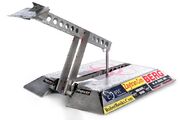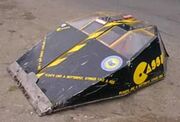Tag: sourceedit |
Voyanuitoa (talk | contribs) No edit summary Tag: sourceedit |
||
| Line 107: | Line 107: | ||
Although extremely effective if designed right, it was difficult to get that right design. It was also possible to become stranded if the robot was flipped over in just the right position (as [[Robochicken]] proved in Series 7, flipping Mega Morg straight into its back after a frontal attack), or there was not enough momentum behind the flip (which cost Ivanhoe as it was lifted onto its side by [[G.B.H.]]). |
Although extremely effective if designed right, it was difficult to get that right design. It was also possible to become stranded if the robot was flipped over in just the right position (as [[Robochicken]] proved in Series 7, flipping Mega Morg straight into its back after a frontal attack), or there was not enough momentum behind the flip (which cost Ivanhoe as it was lifted onto its side by [[G.B.H.]]). |
||
| + | |||
| + | ==References== |
||
<references /> |
<references /> |
||
Revision as of 13:07, 20 July 2016

Lightning self-rights
The self-righting mechanism (or srimech, derived from the words self-righting mechanism) is something of an essential in Robot Wars. In its simplest terms, it is a device used to flip a robot back onto its wheels if it gets flipped over. Although the first attempt to self-right in the UK Series was by Chaos, after being flipped over by Matilda in Series 2, the first successful srimech in the UK Series was used by Cassius also in Series 2, where it used its flipper to right itself after being overturned by Sir Killalot.
Powering
Usually, self-righting mechanisms are powered by either pneumatics (usually as part of a flipping weapon, Chaos 2 and Cassius were some of the first robots to have utilised these systems) or by an electric motor powered by the battery, Hypno-Disc and Panic Attack used these rather rare systems to great effect. However, there are also occasionally self-righting mechanisms powered by other means. Razer's self-righting wings are a good example-they were moved up and down by a steel cable attached to the weapon, allowing it to self-right, as well as give its infamous "salute".
Origins of the Srimech

Biohazard, the first machine ever to self-right
The origins of the self-righting mechanism lie not only in UK Robot Wars, but in the original US competition, and famous robots Biohazard and Vlad the Impaler.
- In 1996, Biohazard defeated rival machine Vlad the Impaler by pinning it against the wall for 30 seconds. The match ended and Biohazard released its foe, but Vlad, apparently disappointed at the loss, turned and used its pneumatic lifter on Biohazard to flip and immobilize it. Biohazard was able to self-right by use of its electric lifting arm. This is generally believed to be the first display of self-righting at a tournament, but it took place after the conclusion of a match and had no bearing on the outcome.
Vlad the Impaler, the first robot to self-right during a battle
- In 1997, in another match between Biohazard and Vlad the Impaler, Vlad demonstrated its special pneumatic device that could quickly and repeatedly pop Vlad back upright from an inverted orientation. The device was successfully used to self-right from an immobilized position several times, but Vlad lost the match in a judge's decision.

Cassius, father of the srimech, the first robot to self-right and manage to continue in the tournament
- In Robot Wars: The Second Wars, Cassius was flipped onto its back by Sir Killalot during the Pinball trial[1]. Despite this, Cassius used its flipping arm to self-right, landing on its wheels and managing to continue the Pinball trial. This was the first recorded time that a srimech had allowed a robot to continue in a tournament.
- Later in that Series, Cassius was fighting reigning UK Champion Roadblock. Cassius was once again flipped over, but used its righting arm to land back on its wheels and go on to defeat Roadblock in battle. This was the first ever recorded instance of a robot going on to win a battle after being flipped.
The term was coined by Rex Garrod after Cassius self-righted for the first time. All three robots are credited with the evolution of the Self-Righting Mechanism, and are all members of The Combat Robot Hall of Fame.
Types

Iron-Awe, the first robot to use an overhead weapon to self-right

Ceros is counted out after losing power to its flipper
During the show's history, there were three different sorts of srimech.
Weapons
One of the ways a robot could self-right was through use of its own weapon. This was in fact the original UK Robot Wars srimech, as Cassius used its flipping arm to right itself, and Chaos could also right using its flipping arm (although it failed on TV). After Series 2, more robots began to use their flippers to self-right, and most robots with flippers, like Firestorm, Bigger Brother and Thermidor 2 were all capable of doing so. In Series 4, Iron-Awe became the first robot to self-right using an axe, and this was followed by others such as Dominator 2 and Terrorhurtz.
The advantage of self-righting through use of a weapon, such as flippers or axes, is that focus can be put on the weapon itself without having to make room for a secondary feature to right the robot. The main disadvantage, however, is that it depleted the effectiveness of the weapon after a while, and if the weapon power ran out, the robot would no longer be able to self right. This ultimately cost robots like Chaos 2 and Tsunami.
| Srimech Type | Description of srimech | Notable robots |
|---|---|---|
| Rear-hinged true flipper | Robots are catapulted in an arch back onto their wheels. One of the most entertaining to watch but the one where C02 depletion is most problematic. | Chaos 2, Thermidor 2 |
| Front-hinged true flipper | Flipper activates and pushes body up and backwards until gravity pulls it back onto its wheels. Does not require an "explosive" flip but fails if pinned or does not have a clear space behind it. | Firestorm 2-5, G.B.H. 2 |
| Rear-hinged flipping arm | Robots are catapulted in an arch back onto their wheels. Easier to use on an angle (when side-stranded) but suffers from the C02 problem potently also. | Gemini, Sir Chromalot |
| Front-hinged flipping arm | Precisely the same as the front hinged true flipper. This was the first weapon used as a srimech. | Cassius, Fire Storm |
| Lifters | The robot is heaved onto its wheels as the lifter opens. Lacks the powerful trajectory that rear-hinged flippers have. | Wild Thing (Series 4-5), Mortis |
| Spiked axes/Bladed axes/Hammers | Functions essentially in the same method as front-hinged flipping arms. Suffer from balance issues if the robot is too wide or heavy (as seen in Bamm Bamm's failure in Series 7) | Dominator 2, Iron-Awe, Terrorhurtz |
| Vertical crushers | An example of this never appeared in a televised battle on Robot Wars, but a single competitor, TX-108, which competed in an unaired battle of Robot Wars Extreme, used a crushing arm that could push backwards as a srimech. This allowed the robot to save weight, at the expense of slow self-righting. | TX-108 |
Separate Mechanisms
Not every weapon was able to right the robot, so often an alternative mechanism was used for robots that did not possess flippers or axes. A huge range of features were used across the show's history.
These srimechs had advantage in that they did not detract from the robot's weapon, but at the same time they could often be easily targeted and were prone to failure if enough damage had been caused. This was of particular relevance to Panic Attack, whose self-righting lid broke after Refbot tried to free it from the arena wall in the Commonwealth Carnage in Extreme Series 2. 13 Black's side-bar srimech was also susceptible to failing, as it did in both of its battles in Series 7.
| Srimech Type | Description of srimech | Notable robots |
|---|---|---|
| Side-Bars | A small, bar-like mechanism that operated with a simple sideways mechanism. It was first used by Hypno-Disc in Series 4, although it would not be seen in operation until Extreme 1. The side-bar was relatively rare. | Hypno-Disc, 13 Black, Ironside 3 |
| Overhead-Bar | The Alien featured a variation of the bar-srimech that functioned overhead, turning the robot over its front. Notably, however, it malfunctioned in Series 5 after getting stuck on its own spinning hammer. | The Alien |
| Rear "Lid" | A rear-mounted srimech which ranged from a simple series of bars (like Cedric Slammer) to a full-covered "lid" (like Panic Attack). These srimechs were often prone to failure: Panic Attack notably only self-righted once in three attempts. | Panic Attack, Cedric Slammer |
| Side Spikes | Pneumatic spikes situated either side of the robot which would push it back over if it was on its side. | X-Terminator (Series 7) |
| Side Arms | A mechanism very similar to the side spikes, small arm-like mechanisms installed into the side of the robot would push it back onto its wheels. These arms were attached low down on the robot, with the pneumatic system installed at the top. | ICU, X-Terminator (Series 5), Eric |
| Tower Mechanism | Sir Chromalot had a unique self-righting mechanism in Series 4 which was largely based on the side arm srimech. Supported by a large tower, a series of arms would push down on the robot, much like an umbrella. This srimech was never seen in action properly. | Sir Chromalot |
| Rollcage | A series of bars mounted on top of the robot to help it roll back over if it was flipped. The main difference between rollcages and the "rollover" design used by other robots is that the bars are exposed and separate from the robot, often vulnerable to damage in the process. | Spikasaurus, Major Tom (Series 6) |
| Wings | First, and most notably, used by Razer, these were most commonly seen in robots with crushers. These were two blade-shaped mechanisms on either side of the robot, which were attached to the crusher by a cable, and would open when the crusher reached a certain "degree". | Razer, Ming 3, Chompalot |
Body Shape
A third, rarer form of self-righting came from the robot's body. Some robots, such as Velocirippa and The Morgue were designed so that no matter how much it was flipped, it would always be able to roll back onto its wheels, in a similar manner to the rollcage feature. The first robot that had this feature was Ivanhoe in Series 2, but it failed to work.
Although extremely effective if designed right, it was difficult to get that right design. It was also possible to become stranded if the robot was flipped over in just the right position (as Robochicken proved in Series 7, flipping Mega Morg straight into its back after a frontal attack), or there was not enough momentum behind the flip (which cost Ivanhoe as it was lifted onto its side by G.B.H.).
References
| ||||||||||||||||||||||||||||||||
